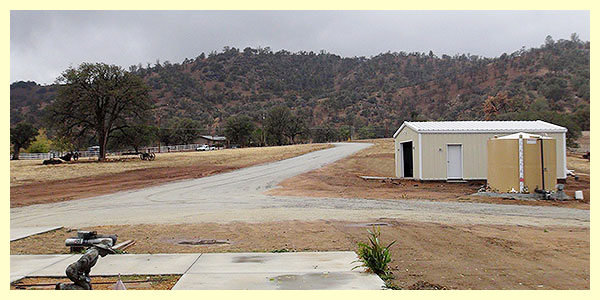Links near the upper left corner will take you on a brief tour of the property. “Our new home” shares history leading to the completion of the house prior to our moving in during 2014. “Construction” features four photos of our home being built. “Patio roof” presents pictures of adding an enclosure above our kitchen porch during 2024. “Plywood shack” presents images of the structure on this spot from 1949 until its demolition in 2013 to make way for our dream home.
Yellow marks our Northern and Western property lines. Old Town Rd is our Southern and Eastern boundary.
Our Amateur Radio station, also known as “ham radio.” This hobby provides free worldwide communication.
This was an extraordinary year for lupine in this Spring view of our property to the south from the dining room.
Acoustics in the Great Room are well suited for the music produced by our 1921 Story & Clark player piano, which was inherited from Dixie’s dad. You can hear the piano play a roll by using the controller at the bottom of this page. Much of our 700-roll collection can be seen in the right half of this photograph. Gaps in the sequence represent spaces being held for paper rolls Dixie is repairing by hand, some of which are from 1905.
The Tehachapi Loop— One of the engineering feats of its day, the Loop was built by Southern Pacific Railroad to ease the grade over Tehachapi Pass. Construction began in 1874, and the line opened in 1876. Rising at a steady two percent grade, the track gains 77 feet (23 m) in elevation in the Loop. Any train more than 4,000 feet (1,200 m) long passes over itself going around the loop. At the bottom of the loop, the track passes through Tunnel 9, the ninth tunnel built as the railroad worked from Bakersfield. The line averages 40 trains each day. Due to its frequent trains and scenic setting, the Tehachapi Loop is popular with railfans. In 1998 it was named a National Historic Civil Engineering Landmark and is designated as California Historical Landmark № 508. —From Wikipedia
Your browser does not support the audio element.
Start (and stop) the player piano music.
She Believes in Me
Your browser does not support the video tag.
A “player piano” is usually an ordinary piano with a mechanical player mechanism added to it at the factory. Two pedals, often called “treadles,” fold down and are pumped with one’s feet, causing the machinery to play the paper roll via suction. When manual playing is desired, treadles are folded out of the way, exposing the familiar soft and sustain pedals for the pianist to use. No other adjustments are required. In fact, sometimes a pianist will foot-pump the treadles while adding harmony with the keyboard. All that’s missing are the soft and sustain pedals, as the treadles are lowered in front of them. The video above lasts one minute and eight seconds, and features a dear friend, Mark Greisen, whom the world lost to Covid in 2019.
Are you looking for the coutant.org microphone site?


